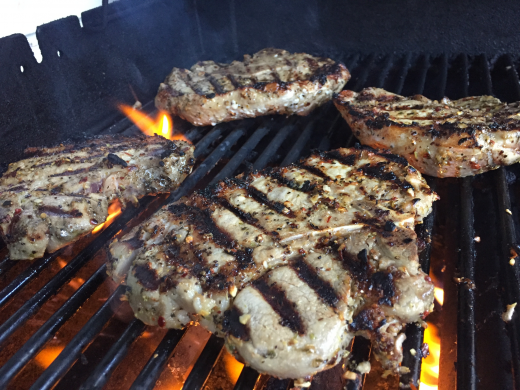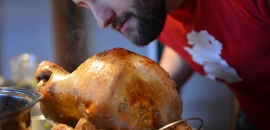Team Temple grills these every week. All year. I don’t exaggerate when I say they are the best steaks I’ve ever had. You can use this method for beefsteaks, but why would you? Porksteaks are way more flavourful. It is a sad day indeed when we run out and can’t get more until the farmstand opens on Saturdays. We prefer nice thick t-bone chops with a good mix of white and dark meat and a nice fat-cap (it’ll crisp off).
There are three keys to porkchop nirvanna: DRY, OIL, REST.
1: Marinate
First thing I do is marinate them with a few splashes of Bragg soy/aminos. I don’t marinate long, just enough to get a bit of umami seeping in. Probably if I did longer, they’d be even better. I take the chops straight out of the fridge for this. I don’t bother letting them pre-warm to room temp. I think this helps keep more of the thick chops rare/med-rare while the outside gets the right amount of crisp/char.
2: Dry
Key number one to crispy chops on the BBQ is to dry them off as well as you can. The best way to do this is with a couple pieces of paper towel. If I use the wettest towels on the chops first, working your way to the new, I can get the total down to one small ‘select-a-size’ per chop. Not too wasteful, and the dryness makes a HUGE difference.
3: Salt
Lay the chops in a (dry!) bowl and sprinkle salt fairly liberally on both sides. Koshering salt works best because you can get more coverage. Don’t be shy with it, most of it will drip off, but it’ll really make a difference in the flavour and crispiness.
4: Season
Make up the rub. I just sprinkle some flavours that work well with the chops. Through much experimentation, I’m currently doing the following. Amounts are guesses based on the relative proportions for four large chops. You almost can’t have too much rub, because it will slough-off with the excess oil.
- 2tsp black pepper
- 1 tbsp chili flakes (for citrus high-notes, not spice)
- 1/2 tsp fennel seeds (roughly crushed)
- 1tsp onion powder
- 1/4tsp granulated garlic
- 1/2tsp aleppo pepper (just a touch for the earthiness, not spice)
- 1tbsp clubhouse greek salad seasoning
5: Oil
Key number two is to pour on lots of olive oil, probably half-a cup. Then mix the chops, seasoning, and oil together in the bowl. You want enough oil that they’re well slathered in it, with a bit of standing oil in the bottom of the bowl.
(Aside: Costco’s Kirkland-brand organic olive oil is FANTASTIC, the best tasting we’ve found for under gold-bullion pricing. It’s quite inexpensive, but amazingly good for raw applications, never woody. It’s what we use for cooking too.)
6: Preheat
BBQ prep. Get the barbie REALLY hot. I throw on all burners full-whack with the lid down until the lid-thermometer pegs out, usually over 700f. When it’s up to temp (and the sizzle guards may be glowing orange near the burner), turn off one side of the BBQ, but keep the hottest part going.
7: Burn!
Chops go on the hottest part of the grill with the LID OPEN. Don’t mind if the olive oil is drippy, but don’t bother trying to get extra oil on the chops. Try to put the fattiest parts over the hottest heat. You’re basically trying to render/crisp the fat on the outside as fast as possible. By that time the rest of the meat will have just the right amount of grilling.
Warning! Because the chops are dripping in oil, they WILL BURN! This is the secret to getting those perfectly crispy chops. The oil will burn, turning the chops into a bonfire, but the ablative burning of the oil and fat-cap will actually protect the chops from burning. Or some such. It’s science and it works. Have faith that the divine pork spirits will protect your chops.
Monitor closely, but DON’T PANIC. Watch carefully, because they should only sit in the bonfire for a handful of seconds before the outside is perfectly charred. Also, please don’t burn your house down. Er. Maybe I should have put that warning first. Keep the lid up while the conflagration is happening!
Grill until the outside is perfect, then move to indirect heat. Move the chops around, trying to get each side of each chop to the nicest looking amount of char. It won’t take long at all. Once they look beautiful, move each chop to the side of the grill with the burners off. They’ll still be blue in the middle, but the outside is done.
Total time over direct heat is maybe 3-4min. Keep your eye on the (flaming) prize!
8: Bake
After all chops are moved off the direct heat (and any flash flames have died down) keep the one side of the grill still burning, but close the lid for indirect heat finishing. You’re going to essentially bake the chops until their internal temp is 105°F. Check the internal temp regularly.
(Aside: The best thermometer I have found is the ThermoWorks Thermapen instant-read thermometer. The ThermoWorks DOT is the best leave-in thermometer, which will make every roast and turkey easier and better. These two are in my absolutely essential kitchen kit.)
Sometimes the chops are different thicknesses and will cook at different rates. I put the cooler chops higher up to cook a little faster. My BBQ has a rack along the back of the grill, and on the indirect side, the top part of the rack will get more heat than the grill surface (lid-closed the heat fills from top down).
I like my chops medium-rare, and taking thick chops off at 105F will result in them being closer to medium, but with rarer bits right near the bone. Thinner chops can cook faster, but I don’t like to take them off before the others, because they’ll start to cool. You want them to retain their heat so they can finish cooking while resting. If some are done early, I move them to the cooler parts of the grill (on my grill up at the front corner opposite the side the burners are still going).
Note: The indirect baking accellerates as it heats up. It can take a while for the chops to get from 80-90, but from 90-120 can go fast!
Total time for indirect baking is probably another 4-5min. Less if you don’t open the lid frequently, which I do often to check the temp.
9: Rest
Key number three: they MUST rest to finish cooking. Quickly remove chops to a plate, piling them together to best retain heat (porkies at the bottom of the piggy pile will cook more). Quickly cover tightly with foil and remove to small insulated space. The microwave is a perfect little resting box. Er… don’t turn it on. ;)
After at least 10 min of resting (20 is ideal, we eat salad while they rest), the high heat on the outside will have sunk in to the middle, finishing the cooking to tender perfection. If you cut into them at 105F, they’ll be pretty blue, but after 10min resting, they’ll be at least med-rare. Sometimes I overshoot medium-rare, but they still wind up super tender with this resting method. Plus, with thick, bone-in porkchops, you’ll always have less well-cooked bits near the bone.
Pink pork is good. We buy good pork, and you haven’t really had to worry about rare pork in the past few decades (statistically it’s safer than beef), so we don’t mind it quite rare near the bone. Dial it in to your tastes.
“Trichinosis is an antiquated disease, and we’ve been cooking pork to medium for a long time now,” says Chef Naomi Pomeroy, of Portland, Oregon’s Beast. Like Pomeroy, other chefs I spoke to argue that medium-rare pork is more succulent, tender, and flavorful than its well-done counterpart. And collectively, these chefs are attempting to steer the gigantic steamship of American cuisine toward embracing it, too.
10: Enjoy!
Try not to make obscene noises (unless your dining partner’s into that). And most importantly, I’d love to hear how it goes!








